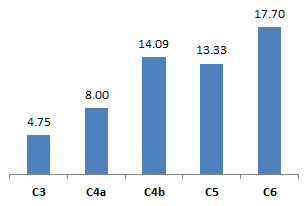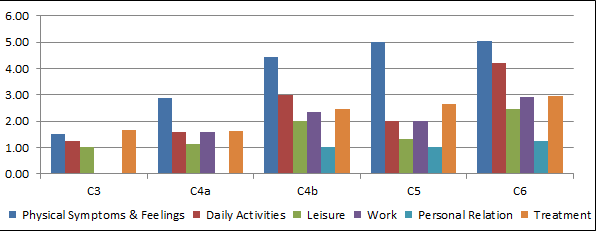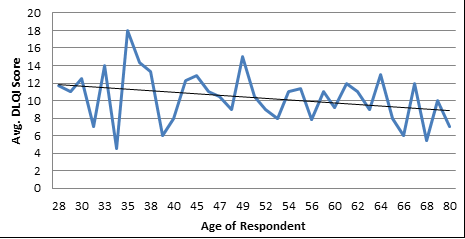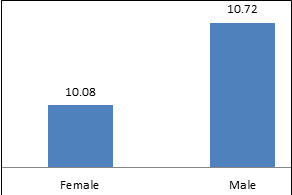Introduction
The World Health Organization (WHO) defines quality of life as "the individuals' perception of their position in life, in the context of the culture and value systems in which they live and in relation to
their goals, expectations, standards and concerns."1 QoL measures have only recently been used as assessment parameters in the management and evaluation of chronic skin diseases. In dermatology, HRQOL can be assessed with generic instruments such as Short Form-36 &12(SF-36 and -12), NHP (Nottingham Health Profile), SIP (Sickness Impact Profile), dermatology specific instruments such as DLQI, DQOLS (Dermatology Quality Of Life Scales) and DSQL(Dermatology Specific Quality Of Life) and condition specific instruments such as those for diseases like acne vulgaris, melasmas. Its use in clinical and research fields allow a more humanized therapeutic approach.
The quality of life of patients with chronic venous disease can be impaired by various aspects including physical symptoms, complications of the disease, functional capacity, mobility, social and employment limitations. Though disease specific QoL measures for CVI exist namely CIVIQ (Chronic Venous Insufficiency Quality of Life Questionnaire) and VEINES-QOL, the native language adaptations of the same have not been made available yet.
DLQI, developed by A.Y. Finlay and G.K. Khan in the year 1994, is considered as the first specific assessment instrument of QoL in dermatology. It comprises of ten questions divided into six domains. The answers are on a Likert scale. It has been validated for 33 different skin conditions and is available in 55 language adaptations. The total score ranges from 0 to 30. Higher the DLQI score, greater is the disease impact.2
The objective of this study is to determine the DLQI score in 100 patients suffering from CVI using the English, Kannada and Urdu adaptations of DLQI questionnaire3 and to correlate the score with clinical disease severity.
Materials and Methods
An analytical and descriptive cross-sectional study was conducted between the period from November 2014 to July 2016 among 100 patients with CVI who attended the dermatology outpatient department of Bangalore Medical College and Research Institute. Approval had been obtained from the Institution Ethics Committee.
We employed a non-probabilistic sampling method. The inclusion criteria were: Untreated patients with CVI who gave an informed consent to participate in the study and exclusion criteria were: arterial disease, congenital venous disease, obstructive venous disease such as deep vein thrombosis and neuropathic disease. A detailed socio-demographic and clinical survey of each patient was performed. Details including age, gender, occupation, parity in females, history of trauma or surgery, family history of varicosities, BMI were collected. Clinical grading of each patient was performed using CEAP clinical classification (Table 1).4 A Venous Doppler ultrasound scan was performed in all patients. Each patient was asked to fill the DLQI questionnaire based on their experience over the past one week. In case of patients who were illiterate or had difficulty reading, they were assisted in filling the same.
To date, no studies have validated the use of DLQI as QoL assessment tool in patients with CVI. However, previously too studies have been conducted in other conditions for which its use has not been validated. The availability in native language adaptations, ease of administration and interpretation led to choosing DLQI as the preferred tool of QoL measurement in CVI. The collected data was analyzed using R software. The internal consistency (reliability) of DLQI in the sample was tested using Cronbach's alpha and was found to be acceptable. The correlation between DLQI score and clinical severity was assessed using Pearson's chi-squared test.
Results
Among the 100 patients included in the study, there were 88 males and 12 females. The male to female ratio was 7.3:1. The mean age of the study population was 48.5 years. In the study, 42% of the patients had complaints for around 9 months, while in few patients it extended over a period of 10 years. The occupation wise distribution of the patients has been given in Table 2. 39% of patients had a healthy weight while 47% were overweight and 14% patients were obese (Table 3). The obstetric score of the 12 females in the study: 4 (33.3%) were P5, 2 (16.7%) each were P2, P3 and P4 while 1(8.3%) each were P7 and Gl. The CEAP clinical profile of patients with CVI is given in Table 4. Among the 100 patients in our study, there were 4 females (33.3%) of CEAP grade C3, 58(70%) males and 4(33.3%) females of grade C4a, 9(10.2%) males and 2(16.7%) females of grade C4b, 3(3.4%) males of grade C5, 18(20.4%) males and 2(16.7%)females of grade C6. Table 5 shows DLQI domain scores and average total score for each CEAP clinical category. Figure 1 shows DLQI total score plotted against CEAP clinical category while in Figure 2 DLQI domain score is plotted against CEAP clinical category. The correlation between average of total DLQI score and clinical disease severity graded according to CEAP system was analyzed using chi square test which showed positive correlation (p<0.05). When the average of DLQI domain scores was analyzed against clinical disease severity, all docorreltion. While the DLQI domain scores' correlation with age and gender were assessed (Figure 3, Figure 4 ), no statiswas seen (p-values = 0.59 and 0.93 respectively).
Table 1
CEAP classification
Table 2
Occupation Wise Distribution of Patients
Table 3
BMI distribution of patients
| BMI | Male n(%) | Female n(%) | Total |
| Normal | 35(39.8) | 4(33.3) | 39 |
| Overweight | 41(46.6) | 6(50.0) | 47 |
| Moderately obese | 12(13.6) | 2(16.7) | 14 |
| Grand Total | 88 | 12 | 100 |
Table 4
Distribution based on clinical impression
| Ceap Grade | Males | Females | Total |
| C3 n(%) | 0(00.0) | 4(33.3) | 4 |
| C4a n(%) | 58(70.0) | 4(33.3) | 62 |
| C4b n(%) | 9(10.2) | 2(16.7) | 11 |
| C5 n(%) | 3(03.4) | 0(00.0) | 3 |
| C6 n(%) | 18(20.4) | 2(16.7) | 20 |
| Total | 88 | 12 | 100 |
Table 5
Correlation between DLQI (domain and total) score and CEAP clinical grade of disease
Table 6
Correlation between DLQI (domain and total) score and CEAP clinical grade of disease
Discussion
A wider understanding of the concept of QoL and its use in clinical practice and research will help in providing a therapeutic approach closer to the patients' needs. The choice of QoL assessment tool depends on various factors such as availability in the patients' language, ease of distribution and handling and, inevitably its comprehensibility. In our study, DLQI was the selected tool as it complied with most of our requirements. The total DLQI score ranges between 0-30. The interpretation of scores is as follows: 0-1- No effect, 2-5- Small effect, 6-10-Moderate effect, 11-20- Very large effect, 21-30-Extremely large effect on patient's life. A higher DLQI score highlights the need for active intervention.
The socio-demographic characteristics of the sample showed a higher proportion of males compared to females and the predominant age group was 40-49 years. Majority of our patients had reported prolonged standing during their occupation. In their studies on chronic venous disease by Ruckley et al.5 in 2002 and Criqui et al.6 in 2003, male predominance was observed. Scott et al.7 " had observed a 6% increase in risk of CVI per 1 year increase in age. Abramson et al.8 , in his community based study in Jerusalem in men and women aged 20-64 years, also found prevalence of chronic venous disease higher among subjects with protracted orthostasis.
In our study, 46.6% of men and 50% of women were overweight and 13.6% and 16.7% of men and women respectively were obese while the remaining population had a normal BMI. We also observed that increased BMI is correlated positively with severity of disease more in women compared to men. Gourgou et al.9 had observed in their study a two fold increase in likelihood of developing CVI among obese subjects.
CVI includes the severe forms of CVD - CEAP clinical grades C3 to C6. The distribution of subjects in our study was as follows: 4 females (33.3%) of CEAP clinical grade C3, 58(70%) males and 4(33.3%) females of grade C4a, 9 (10.2%) males and 2(16.7%) females of grade C4b, 3(3.4%) males of grade C5, 18 (20.4%) males and 2(16.7%) females of grade C6. The common clinical manifestations of CVI found in the study population were edema, stasis eczema, LDS and ulcers whereas PPD, atrophie blanche were less common. Kurosh Parsi in his review article10 has mentioned edema, corona phlebectatica paraplantaris (ankle flare), stasis dermatitis, pigmentary changes, atrophie blanche, LDS and skin ulceration as the common cutaneous manifestations of CVI, while PPD, Pseudo KS are seen less commonly. The average total DLQI scores for CEAP clinical grades C3, C4a, C4b, C5 and C6 in our study were 4.75, 8.00, 14.09, 13.33 and 17.70 respectively. The average total DLQI scores showed positive correlation with the clinical disease severity. The worst affected parameters in descending order of significance were physical symptoms and feelings, daily activities, work and treatment. Most of the patients were reluctant in disclosing effect of disease on their personal lives.
In our study, no significant difference was noticed in both DLQI total and domain scores based on age and gender. When literature was reviewed for impact of chronic venous disease on QoL, studies using SF- 36 as assessment tool were available. In the San Diego population study by Kaplan et al.11 " on more than 2257 participants, SF- 36, which includes eight subscales clustered into two groups: physical and mental health, was used as the QoL assessment tool. In their study, it was observed that venous disease affects the functional scales but does not have much impact on the well-being aspects of patients. In the study by Kurz et al.12 too similar observations were made.
Amongst the 100 subjects, 4% had a small impact of disease on their lives, 62% had a moderate impact whereas the rest 34% had their lives affected very much by CVI.
Although the use of DLQI for QoL assessment in patients with CVI has not been reported in literature, it still remains the most commonly preferred assessment tool in dermatology, hence its use in this study. The major limitations to this study are a very small sample size. Simultaneous assessment of depression was not performed going by the observation that depression leads to a poorer perception of QoL. DLQI is yet to be validated for use in CVI.
In summary, venous disease is a prevalent, less reported condition with a lot of accompanied morbidity. Dermatologists, when approached, treat CVI as a cosmetic problem but its tentacles extend beyond its appearance. It tarnishes the self-esteem, diminishes the functional aspects of life and taints the emotional health of the patients. Thus, incorporating QoL assessment tools in treatment of CVI helps in a holistic approach to the patient. This can result in better patient gratification




